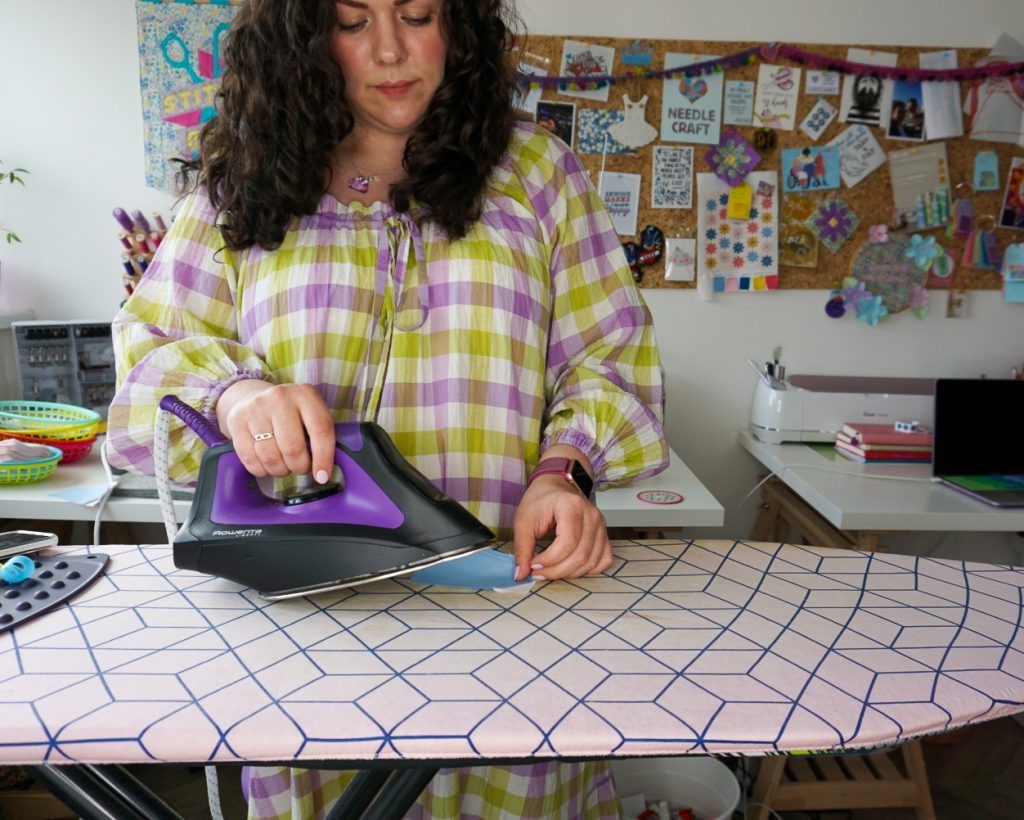Pressing is a critical step in sewing and quilting, essential for achieving a professional and polished finish on your projects. While it might not be everyone’s favorite task, using the right pressing tools can make the process more efficient and less physically demanding. This guide will explore essential pressing tools and, importantly, how to care for them to ensure they remain in top condition for years to come.
Essential Pressing Tools and How to Maintain Them
To make pressing easier and more effective, especially if you experience chronic pain or fatigue, consider incorporating these tools into your sewing setup. Proper care for each tool will maximize their lifespan and performance.
Ironing Board
The ironing board is the foundation of your pressing station. Setting it at the correct height is crucial for comfort and preventing strain. Aim for a height where your elbow is at a right angle when holding the iron.
Care Tips:
- Check and tighten legs: Ensure the legs are stable and won’t wobble to prevent accidents.
- Replace the cover and padding: Over time, the cover can become scorched or stained, and the padding can flatten. Replace them to maintain a smooth pressing surface. Look for scorch-resistant covers and thick padding for best results.
- Clean the cover: Regularly wipe down the cover with a damp cloth to remove dust and fabric lint. For tougher stains, follow the manufacturer’s cleaning instructions, or consider a mild fabric cleaner.
Pressing Mat (Wool & Others)
Pressing mats, especially wool mats, are excellent for small projects and quilting. They retain heat, pressing fabric from both sides simultaneously, saving time and effort.
Care Tips:
- Wool Mats:
- Avoid getting them wet: Wool mats can felt and shrink if saturated. Spot clean spills gently with a damp cloth.
- Store flat: To prevent creases, store wool mats flat.
- Protect from moths: If storing for extended periods, use moth-repellent measures like cedar or lavender.
- Other Mats (Silicone, Teflon):
- Clean with a damp cloth: Wipe away any residue or starch buildup.
- Heat Resistance: While heat-resistant, avoid prolonged direct contact with extremely hot irons to extend their life.
Seam Roller
A seam roller is a valuable tool for ‘pre-pressing’ seams, especially helpful for delicate fabrics or intricate work. It helps to flatten seams without the direct heat of an iron, making it easier to handle small pieces.
Care Tips:
- Clean after use: Remove any fabric fibers or threads that may accumulate on the roller. A soft brush or lint roller works well.
- Store properly: Store seam rollers in a drawer or tool holder to protect the rolling mechanism from damage and dust.
- Check for smooth rolling: Periodically ensure the roller moves smoothly. If it becomes stiff, a tiny drop of sewing machine oil at the pivot point might help.
Pressing Hams & Rolls
Pressing hams and seam rolls are shaped cushions used to press curved seams and darts, allowing you to mold fabric into desired shapes.
Care Tips:
- Storage: Store them in a dry place to prevent mildew. Keeping them in a fabric bin or drawer will protect them from dust and damage.
- Spot clean only: If they get stained, gently spot clean with a mild detergent and water. Avoid soaking them, as this can distort their shape.
- Maintain shape: If they lose shape over time, you can sometimes reshape them by hand. Ensure the filling remains evenly distributed.
Silicon Iron Mat
A silicon iron mat provides a safe place to rest your hot iron horizontally, reducing strain on your wrist and arm compared to constantly standing the iron upright.
Care Tips:
- Regular cleaning: Wipe the mat regularly with a damp cloth to remove any starch, melted fusible web, or fabric residue.
- Heat resistance: While silicon is heat-resistant, avoid leaving the iron in one spot on the mat for extended periods at the highest heat settings.
- Check for damage: Inspect the mat periodically for any tears or damage. Replace if it becomes compromised to ensure continued safety.
General Tips for Tool Longevity
Beyond tool-specific care, these general practices will help extend the life of all your pressing tools:
- Gentle Use: Avoid excessive force when pressing. Let the heat and steam do the work.
- Proper Storage: Store tools in a clean, dry place away from direct sunlight and extreme temperatures.
- Regular Cleaning: Keep your pressing area tidy and tools clean to prevent buildup of dust and residue.
By properly caring for your pressing tools, you not only ensure they function optimally but also make your sewing process more enjoyable and efficient. Taking a few moments for maintenance will save you time and money in the long run, keeping your tools ready for every project. What are your favorite pressing tool care tips? Share them in the comments below!

